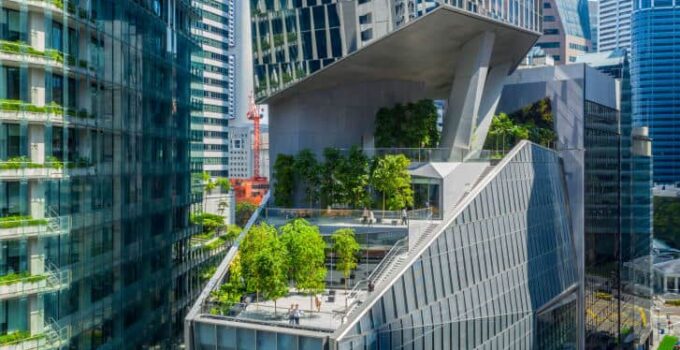With people’s ongoing commitment to sustainable living, architects and designers are revolutionizing outdoor architecture by integrating eco-friendly practices. By embracing innovative and environmentally conscious solutions, outdoor spaces can be transformed into sustainable havens that benefit both the environment and the people who inhabit them.
And this article explores a range of sustainable practices, including timber screening, used in outdoor architecture and highlights their positive impact on the environment. From material choices to energy-efficient design, let’s delve into the world of sustainable outdoor architecture.
Green Roofs and Living Walls
Source: pinterest.com
Green roofs and living walls have gained popularity as sustainable solutions in outdoor architecture. Covering rooftops or walls with vegetation, these features provide numerous environmental benefits. Green roofs reduce energy consumption by insulating buildings, mitigating heat island effects, and improving air quality. Additionally, they can collect rainwater, reducing the strain on drainage systems. Living walls contribute to air purification, noise reduction, and biodiversity enhancement, creating vibrant and ecologically diverse outdoor spaces.
Rainwater Harvesting and Permeable Surfaces
Water scarcity is a pressing global issue, making rainwater harvesting a vital practice in sustainable outdoor architecture. By incorporating systems to collect and store rainwater, architects can reduce the demand for freshwater resources for irrigation purposes. Permeable surfaces, such as permeable pavement or gravel, allow rainwater to infiltrate the ground, replenishing groundwater levels and reducing stormwater runoff. These practices promote water conservation and help maintain the natural water cycle.
Solar Energy Integration
Source: archdaily.com
Solar energy can be harnessed in outdoor architecture to power lighting, heating, and other electrical systems. It is clean and renewable, and hence, incorporating solar panels in outdoor spaces provides an opportunity to generate energy while minimizing carbon emissions. Solar-powered lighting not only illuminates pathways and public spaces but also enhances safety and security, all while reducing the reliance on traditional electricity sources.
Sustainable Materials and Construction Techniques
The choice of materials and construction techniques plays a crucial role in sustainable outdoor architecture. Using locally sourced and recycled materials spares you from the process of transportation of materials and your dependency on mining.
This reduces the carbon footprint associated with these processes. Sustainable construction techniques, such as modular construction or adaptive reuse, minimize waste and energy consumption. So, prioritizing sustainable materials and construction practices can help you contribute to a circular economy and reduce the environmental impact of outdoor architectural projects.
Timber Screening
This method has gained popularity as an eco-friendly and visually pleasing solution for privacy in outdoor architecture. By using wooden panels or slats, this sustainable practice contributes to reducing carbon emissions and adds a touch of natural beauty to outdoor spaces.
With its warm and inviting appearance, timber screening enhances the aesthetics of residential gardens, commercial courtyards, and public parks, blending harmoniously with the surroundings. As such, choosing it as a privacy solution allows individuals to support sustainable materials while creating a serene and visually appealing atmosphere.
Biodiversity Enhancement
Source: discoverwildlife.com
Preserving and enhancing biodiversity is a vital aspect of sustainable outdoor architecture. Incorporating native plants, creating wildlife habitats, and designing green corridors help promote biodiversity and support the local ecosystem. These practices attract pollinators, birds, and other wildlife, fostering a harmonious relationship between humans and nature. Biodiversity enhancement in outdoor spaces not only contributes to the ecological balance but also provides an enriching and immersive experience for visitors.
Sustainable solutions in outdoor architecture offer a transformative approach to designing spaces that harmonize with the environment. From the integration of green roofs and living walls to rainwater harvesting, solar energy utilization, sustainable materials, and timber screening, architects are driving the shift towards eco-friendly practices.
By prioritizing sustainability, outdoor spaces become more than just aesthetically pleasing; they become agents of positive change, benefiting both the planet and its inhabitants. So, let’s continue to embrace and advocate for these sustainable practices, fostering a greener and more resilient future for outdoor architecture.




